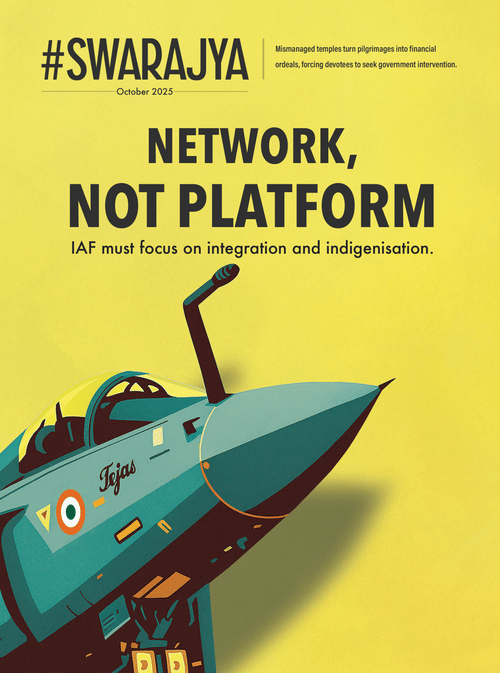Culture
A Chronicle Of India’s Dying Professions
Urmi Chanda-Vaz
May 07, 2016, 03:43 PM | Updated 03:43 PM IST
Save & read from anywhere!
Bookmark stories for easy access on any device or the Swarajya app.


No respectable lover of Indian history and culture can walk nonchalantly past the aisle of a bookstore when the title of a certain book on a certain shelf says The Lost Generation: Chronicling India’s Dying Professions. And if the title of the book doesn’t convince you enough to buy it, a very cute illustration of a pair of dentures and a testimonial by Gulzar saab on its cover will.
Nidhi Dugar Kundalia definitely shows her journalistic penchant for attention-grabbing ‘headlines’ on the cover of her debut book. In fact, her skills as a journalist are perhaps what made this book possible. One must laud her for her extensive research, an eye for detail, and objectivity right at the outset.
The book chronicles 11 of the old India’s dying professions, including ‘The Godna (tattoo) Artists of Jharkhand’, ‘The Rudaalis (mourners) of Rajasthan’, ‘The Genealogists of Haridwar’, ‘The Kabootarbaaz, (pigeon rearers) of ‘Old Delhi’, The Storytellers of Andhra’, ‘The Street Dentists of Baroda’, ‘The Urdu Scribes of Delhi’, ‘The Boat Makers of Balagarh’, ‘The Ittar Wallahs of Hyderabad’, ‘The Bhisti Wallahs’ (water carriers) of Calcutta’ and ‘The Letter Writers of Bombay’. One runs out of breath just reading the number of places in the index; imagine the extensive traveling the author must have had to do to put it all together.
The author picks an interesting mix of places and professions from the vastness that is India and proceeds to offer a slice-of-life from each of those obscure grounds. Some places are truly geographically obscure, such as the forest hamlets of Jharkhand or the far-flung villages of Rajasthan. But the others are obscure from our collective vision, even in plain sight. The author travels in a time machine as it were, when she goes to these places looking for the last practitioners of dying practices.
One of the toughest places, by her own admission, was the Naxal-infested tribal village near Ranchi where she sought to interview a Godna artist and some tribal women who get these ritual tattoos done. In this, as in all other chapters, she posits an interesting all-round account of the profession. She mentions the earliest historical records, the associated myths and superstitions, the socio-economic conditions and its cultural implications.
Sample this:
‘When the God of Death, Yamraj, approaches her during her time of death, he will immediately identify her and not confuse her with her husband..... These (the tattoos) are our ornaments, our assets. The only things we take with us to the heaven... Godna finds its roots in ancient India... Around the sixteenth century, Tavernier, a French traveler and jewel merchant, wrote in an article that the women of Banjera tattooed their skin from the waist upwards. These nomadic communities did this as a mark of identity as they wandered from place to place.’The Lost Generation: Chronicling India’s Dying Professions
The number of details included makes the book credible,and not boring. Her research is sewn effortlessly into the narrative, and her efforts are clear to see in the impressive bibliography at the end of the book. Her sensitivity to local customs and the importance they hold for these micro societies is also worthy of admiration.
Apart from the professions, the author is also an astute observer of people. These fading professionals come alive in the pages of this book, where some zealously protect their ancestral crafts and some count the days listlessly waiting for their curtain calls. Whether it Feroja, the rudaali bemoaning her paltry income; the Burrakatha storytellers of Andhra weaving together mythical and political stories; or Anil Sood, the most famous kabootarbaaz of Delhi, waxing eloquent about his ‘babies’, each person and his account is believable and human.
But what strikes you most is the nostalgia that hangs thick over all the stories. As one reads of a time when these professionals were not only important but also indispensable to the society, one cannot help but feel a jab of pity in one’s chest. The poverty and desolation of most of these people is so compelling that one almost feels guilty for having progressed and rendered them redundant.
This is how the author effectively laces fact with emotion in this book, and keeps her readers hooked. Sometimes, she also veers towards the poetic in a bid to juxtapose beauty with grim reality, but she is clearly a better journalist than a poet. When she starts an account with a description of the scenario, her metaphors seem forced and her imagery crowded. Too many sights and sounds find themselves cramped into a paragraph such as this:
Creepers snake up tree trunks, draping the roofs and windowsills, wrapping themselves up telephone poles and latching on to wires. Frogs play hopscotch around puddles where worms make their homes in the rains. A drenched dog whimpers on its way, scavenging for leftovers. An oily slick of mud, resembling dirty cotton balls that have been torn to shreds, runs into an isolated home from which a sari-clad woman scurries out, looking up at the dark skies...The Lost Generation: Chronicling India’s Dying Professions
But beyond these indulgent tropes, the book is definitely a fantastic first attempt. It does well what it promises to do by painting a powerful, if not pretty picture of a generation of people whose lives and livelihoods are slowly fading into oblivion. We can only read and nod our heads at the inevitable.
The author is a psychologist by training, a journalist by profession, and an Indologist in the making





